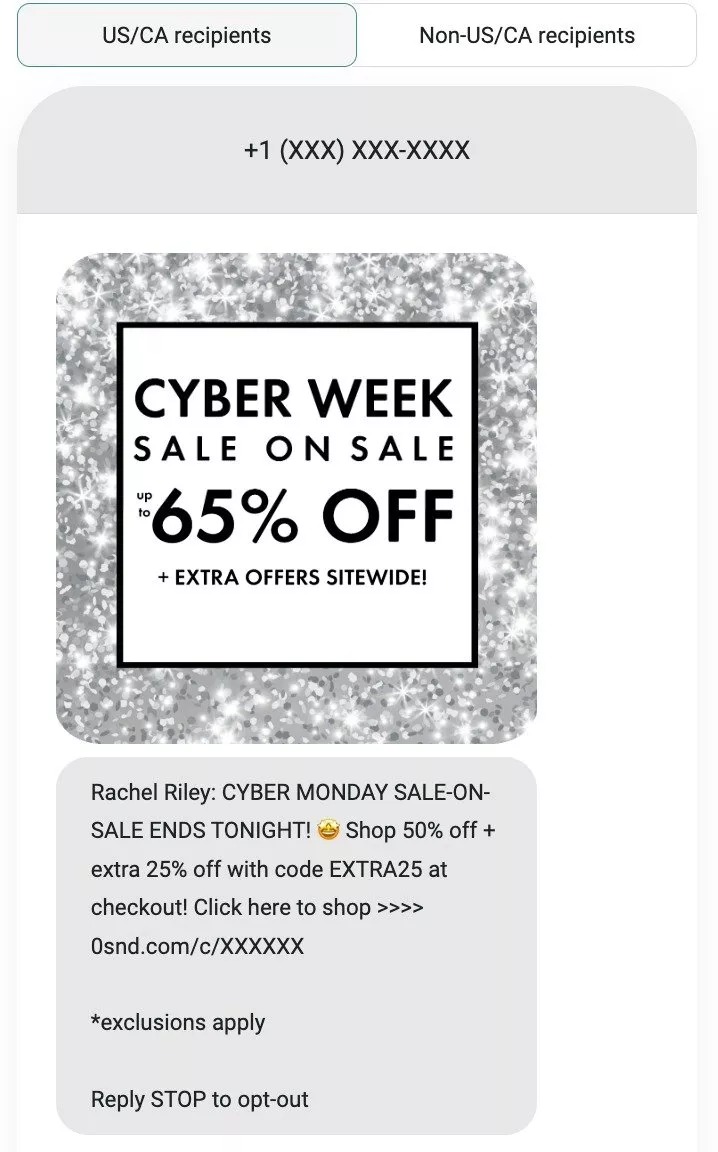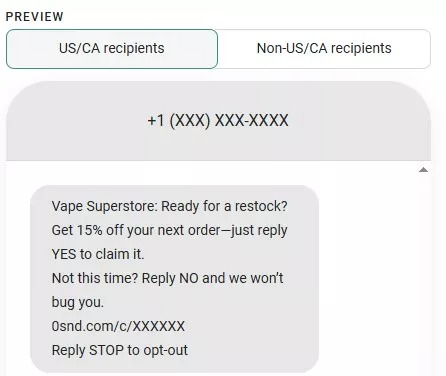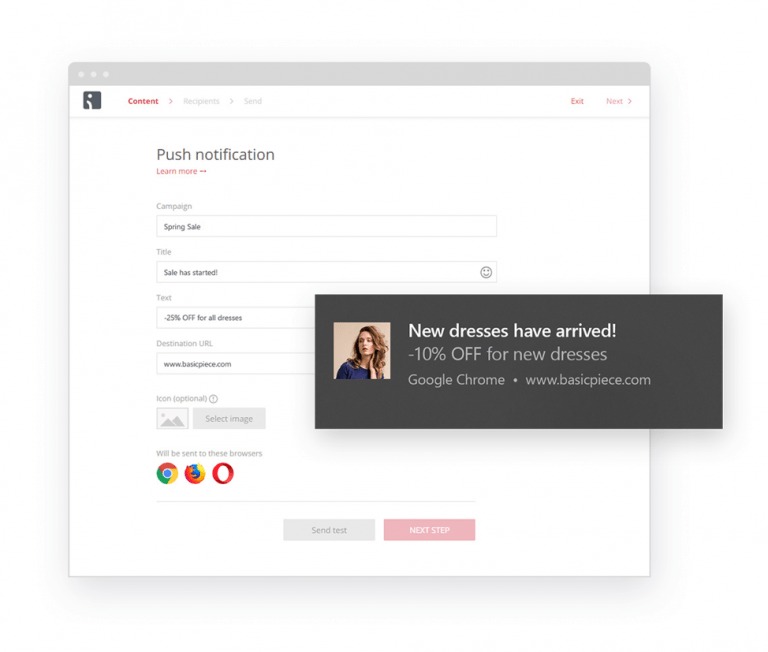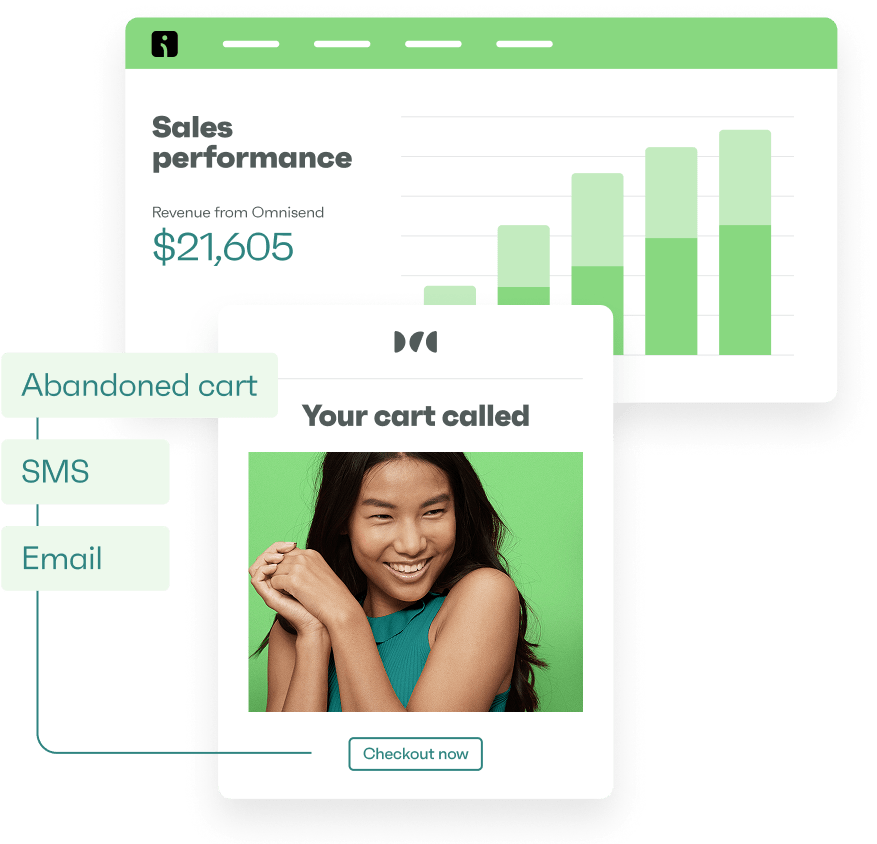Drive sales on autopilot with ecommerce-focused features
See FeaturesThere has always been a constant fight for customer attention, and the dilemma between push notifications vs. SMS has long been a difficult choice. After all, these are two of the most common channels businesses rely on to have a direct line with the customers.
Both have unique strengths and drawbacks. SMS is often valued for its high open rates, making it ideal for urgent updates. Push notifications, on the other hand, help drive app engagement and deliver real-time updates.
The choice depends on your audience and the type of message you want to send. In this post, we’ll break down the differences between push notifications vs. SMS and explore when to use each to help you decide.
Push notifications vs. SMS: What’s the difference?
Both SMS and push notifications are marketing channels that deliver messages quickly. To determine which is right for your business, it’s important to understand each.
What are push notifications?
Push notifications are short messages sent by mobile apps or websites directly to a user’s device. They appear as popup alerts on the lock screen, notification bar, or inside the app.
Because they are tied to device usage, push notification marketing is great for sending personalized reminders, promotional updates, or engagement triggers.
See an example of a push notification by Death Wish Coffee below:

What is SMS marketing?
SMS, or Short Message Service, delivers text messages directly to a user’s phone number, regardless of whether they have an app installed.
SMS marketing is effective for time-sensitive alerts, order confirmations, or promotional offers.
Here’s an example of SMS from Rachel Riley, showing a time-sensitive promotional text:

One difference between push notifications and SMS lies in accessibility and reach. SMS can connect with anyone with a mobile number, while push notifications require users to have an app installed and opt in to receive alerts.
You can also compare push notifications vs. text messages in terms of visibility. SMS messages go directly to the phone’s inbox and stay there until deleted, while push notifications can disappear if ignored. Here’s a quick comparison of push vs. SMS to highlight their core attributes:
| Attribute | Push notifications | SMS messages |
|---|---|---|
| Delivery | Via mobile apps or websites, shown on device screens | Sent to phone numbers through carrier networks |
| Cost | Free (after app setup) | Usually charged per message sent |
| Reach | Limited to app users who opt in | Universal, anyone with a mobile number |
| Opt in | Requires app installation and user permission | Requires phone number and consent |
| Personalization | Highly personalized, behavior-based | Limited to text content, but reliable |
Reach and engagement: SMS vs. push notifications
When you compare push vs. text notification, one of the biggest differences is in the level of reach and engagement:
- In terms of reach, SMS messages are guaranteed to be delivered to nearly anyone with a valid mobile number who opts in to receive messages. Per the 2025 Consumer Texting Behavior (CTB) report, 86% of consumers have opted in to receive business texts.
- Push notifications require users to install the app or enable them on a website and opt in to receive alerts. According to Airship Mobile App Push Notifications Benchmarks for 2025, push notification opt-in rate for some industries was as high as 79.7% on Android devices and 74.1% on iOS devices.
- Comparing push notifications vs. SMS in terms of engagement, SMS typically outperforms push messages. SMS open rates are reported at about 98% per the previously cited CTB report. On the other hand, push notification average open rate across industries in 2024 was 10.7% on Android devices and 8% on iOS devices.
- Click-through rates also highlight a gap. Android push notifications average just 2.75% CTR, and iOS is lower at 1.71%, while SMS marketing typically achieves between 21 and 35%.
- When it comes to immediacy of delivery, push notifications appear almost instantly, especially if the device is online. SMS is also fast, but delivery depends on the mobile network. Some delays can happen during high traffic or network congestion.
- However, SMS has the edge in terms of reliability. Since it uses cellular networks, it works even without Wi-Fi or mobile data. This makes it more dependable in areas with poor internet. Push notifications require the internet, an app or browser permission, and often active settings.
Cost and ROI: Which channel pays off more?
Cost is another important factor to consider when comparing push notifications vs. SMS marketing. SMS comes with a per-message fee that can add up fast, especially for bulk SMS campaigns. Prices vary by region and provider, but a standard SMS message for US recipients using Omnisend costs $0.015.
Despite this, SMS delivers a strong return on investment because of its reliability and high engagement rates. In fact, statistics show SMS campaigns achieve an ROI as high as 44.8%. Well-targeted campaigns, such as abandoned cart reminders or VIP alerts, can lead to more impressive results.
Push notifications, by contrast, are free to send once you have an app or a web push system in place. There are no per-message charges, which makes them appealing for businesses on a tight budget.
But engagement potential is lower, and the hidden cost lies in maintaining audience engagement. Also, opt-in fatigue is another limiting factor, with many users muting or disabling notifications over time.
For small businesses, if you only need to reach a few thousand subscribers, SMS may be worth the spend because every message counts. Push can still play a role, but its impact is limited without a large base of active users.
For larger businesses with established apps or web platforms, push notifications can scale well.
Customer experience: SMS vs. push notifications
While both push notifications vs. SMS deliver quick communication, the way they are received and perceived by customers can be very different.
SMS is personal and direct. Because of this, SMS feels urgent and important. However, the same directness can feel intrusive if SMS is overused. Pushy or too many texts can frustrate customers, leading them to unsubscribe or ignore future campaigns.
See how Vape Superstore uses SMS to make offers feel personal and less pushy, giving customers the choice to reply yes for a discount or no to skip:

Push notifications appear as alerts, often prompting users to take quick action. Customers typically view push messages as more casual than SMS. As such, they work well for reminders, such as a flash sale that’s starting soon or a gentle nudge to check out new content.
They are also less intrusive because users can quickly swipe them away. However, this ease of dismissal can be a drawback. If push alerts are not relevant or frequent enough, they risk being ignored.
Here’s an example of how a push notification is used to highlight a discount:

When to use SMS vs. push notifications
The choice between push notifications vs. SMS depends on context, timing, and customer expectations. Both channels have strengths that make them better for specific situations.
When SMS works best
SMS should be reserved for moments that require attention right away, which makes SMS ideal for:
- Order updates: Shipping confirmations or delivery alerts
- Time-sensitive offers: Short-term promotions or VIP discounts
- Abandoned cart recovery: A reminder that nudges shoppers back to complete checkout
When push notifications work best
Push notifications are better for reminders or engagement prompts that don’t need urgent action. They’re effective for:
- App reminders: Bringing users back to explore features or complete an action
- New content alerts: Notifying subscribers about fresh blog posts or articles
- Flash sales: Quick alerts that encourage engagement without feeling too intrusive
The real power comes when you use both channels. An omnichannel marketing strategy ensures your message is delivered in the right way at the right time. For example, you might send a push notification first, and if the shopper doesn’t engage, follow up with an SMS.
With Omnisend, a marketing automation software, you can set up automations that send a push reminder first, then an automated SMS message if the shopper doesn’t engage, all from one dashboard.
Quick sign up | No credit card required
“Our returning customers already made up a significant portion of our revenue, but Omnisend allowed us to engage them more effectively through multiple channels. By pairing time-sensitive promotions with SMS and push notifications, we’ve seen incredible results.”
Shan Jiang, Customer Growth Manager at Kate Backdrop
Kate Backdrop now enjoys 1:300 ROI using Omnisend omnichannel marketing and a 62% view rate for push notifications. Read the full case study here.
Push notifications vs. SMS: Which should your business choose?
When it comes to push notifications vs. SMS, the decision depends on your goals. SMS is the more reliable option. Messages land in the customer’s inbox, are almost always opened, and are perfect for urgent updates.
Push notifications are a low-cost way to reach customers. They’re free to send and great for reminders or casual brand touchpoints.
For most businesses, the best approach isn’t about choosing between push notifications vs. SMS, but combining both. With Omnisend, you can consolidate SMS, push, and email into a single platform. That way, you get the cost benefits of push messages with the reliability of SMS.
FAQs
Yes, many businesses use both. Push is great for reminders and low-cost engagement, while SMS ensures urgent messages are seen.
Customers expect SMS for urgent and personal updates. Push works better for casual engagement. However, push notifications vs. SMS comparison isn’t about customer preference alone but also involves choosing the right message for each channel.
For urgent communication, yes. SMS has higher open rates, faster reads, and stronger click-throughs. Push is more effective for lightweight engagement at scale. Effectiveness in push notifications vs. SMS depends on your goal.
Push notifications are cheaper since they’re free to send once you have an app or system. SMS has a per-message cost, which adds up with volume. But when comparing push notifications vs. SMS, cost alone isn’t the full picture. SMS often delivers higher ROI per message because it drives more reliable conversions.
TABLE OF CONTENTS
TABLE OF CONTENTS


No fluff, no spam, no corporate filler. Just a friendly letter, twice a month.

 OFFER
OFFER







